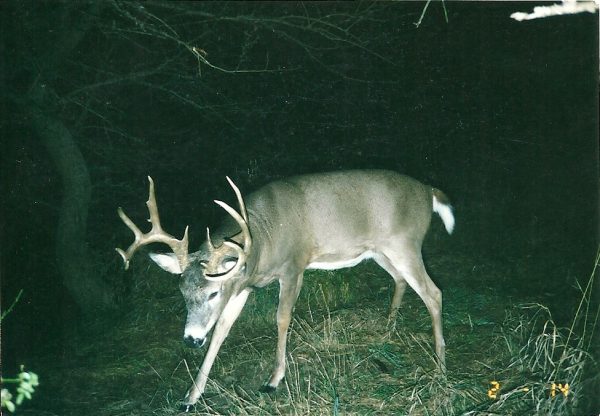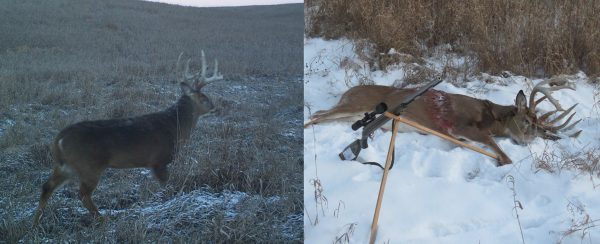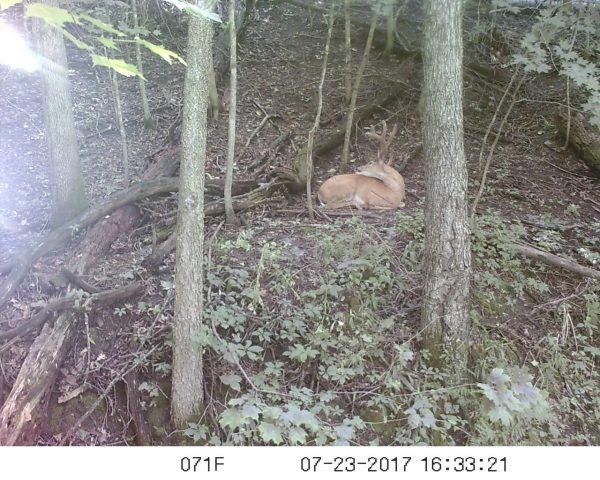
By Joe Elsinger
The memory of my first trail camera I purchased in 2004 is still vivid. It could take 36 pictures in a row using a roll of 35mm film. It made a loud w-r-r-r-r sound advancing the film after each shot and scared the bejeezus out of deer. And when the role was filled, I would race to the drug store to get it developed. How times have changed!
This is the biggest buck I got on trail camera that first year of use. The photo quality was great but the buck probably was scared into the next county from the sound and flash.
This coming fall, millions of trail cameras will probably be deployed in the woods. I have not seen good data on how many trail cameras are out there these days, but what little there is suggests several hundred thousand are just sold every year.
The modern deer hunter’s love affair with trail cameras is obvious.
Checking cameras is like Christmas morning. And we all tell ourselves it’s for the benefit of our hunting. But is it really?
A good trail camera documents activity within an area 80-100 feet long and 30-50 feet wide. Field scan modes observe somewhat more. Imagine how much you would miss if you only observed this small of an area while hunting. Yet many hunters depend completely on trail cameras as scouting tools.
I can recite what I have heard from a dozen outdoor personalities: Carpet your property with cameras, check them about once a week, when you get photos of a buck several times in one spot hunt that location and kill the buck.
In my opinion that is the most underproductive way to use a camera for real world hunting and sets you up to stay one step behind the buck all season long. Fall is a time of constant change. Weather, food sources, hunting pressure, and rut activity are constantly changing. Look closer at the few successful examples of this and you usually find a manicured hunting property where hunting pressure is minimal and food sources pretty stable.
Perhaps the biggest challenge of trail cameras is the affect they have on a hunter’s priorities and instincts. The goal of a filled tag can degenerate into just getting a good photo. The desire for that photo tempts you into checking the camera more often. Your priorities no longer match your hunting goals. Experienced hunters usually suggest trusting your gut. Reliance on trail cameras can hurt that instinct. Trail cameras then fuel indecision – paralysis by analysis. I know these demons too.
Trail cameras can affect deer movement too, although most often it is the human odor and intrusion while checking them that does the damage. I have watched deer, particularly older bucks and does, skirt the location of trail cameras. Some deer can seem photogenic but most are not. I suspect some cameras emit ultrasonic noises that deer notice.
Cameras hung above head height and angled down toward expected movement are most likely to be missed by both deer and thieves but even then deer notice ground scent left from frequent trail camera checks. If you don’t believe me, leave a camera for a month or more where you otherwise would check one frequently and you probably will notice a difference.
Yet with all this said, trail cameras can be the most powerful scouting tool available to the modern deer hunter – excluding your brain and your boots.
My trail camera strategy continues to evolve each year but still usually falls into the following two categories.
1. INVENTORY
You can only kill a certain size buck if it is out there. It’s also much easier to let a buck walk when you know bigger ones are around. Every summer and fall I hang cameras near major food sources, travel corridors, and primary scrapes to inventory bucks. These cameras are fairly easy to access and most activity is expected to be nocturnal. Inventory cameras are rarely near kill locations. All I want from that camera is to tell me who is around. A very common mistake I see is hunters using inventory cameras to replace scouting and woodsmanship. Cameras supplement these skills but do not replace them.
Several years ago I hung a camera on a unique property that did not have a single tree big enough for a stand. I knew there was good post rut movement across it to a major food source. Without this trail camera photo the old warrior would never have fallen to my muzzleloader a few weeks later on a bitter cold late season hunt.
2. LONG TERM DEPLOYMENT
This is where trail cameras show their power. I hang some cameras in deep cover for months at a time. These cameras are left undisturbed to avoid impacting normal movement. They may be located at potential stand sites that won’t be hunted that year or anywhere I want to better understand travel patterns, particularly in and around bedding areas. The information I have gained from this strategy is eye opening.
Observing a big mature public land buck in and around his bed is usually only possible with long-term deployment of a carefully-placed trail camera.
These long term camera deployments have allowed me to correlate bedding and travel patterns with wind, temperature, cloud cover, sunlight, rut phase, hunting pressure and other factors. This information has led to much more efficient hunting.
This table lists daylight buck activity on one public land trail camera set last fall. There were spikes in rutting activity Nov 1-3rd and Nov 11-13th with a lull November 4th to 9th. It’s worth noting that this location had spikes of activity around a week different than “typical” rut dates for the greater area. Such local variations are often annual. There was less activity on weekends until late in the rut which indicates nearby hunting pressure. Activity favored clear skies, afternoons, and avoidance of W and NW winds.
WIRELESS TRAIL CAMERAS
Any current discussion of trail cameras would be incomplete without mention of wireless cameras. They are changing the face of deer hunting as we speak. The primary reason is obvious – data sent near real time.
Real time data is powerful but I predict that many of the same limitations will continue to frustrate hunters. A wireless trail camera observes a tiny area compared to a human in the same spot. Wireless cameras will fog your hunter’s instinct to an even greater degree. Wireless cameras will tell you what a buck did five minutes ago but you still need an understanding of the deer and the land to guess what he will do tomorrow.
I do not know what trail cameras will look like in 10 years nor do I know if I will still use them. My trail camera observations have taught me a lot about deer and also helped me kill quite a few bucks but I do miss the awe of the unknown.
Good luck deciding if, where, and how you will use trail cameras this fall.
Joe Elsinger
If you’d like more from Joe, listen to Episode #150 of the Wired To Hunt Podcast or click here to view other articles of his on Wired To Hunt. And if you liked this article, you might also enjoy The 7 Greatest Dangers of Trail Cameras.










Conversation